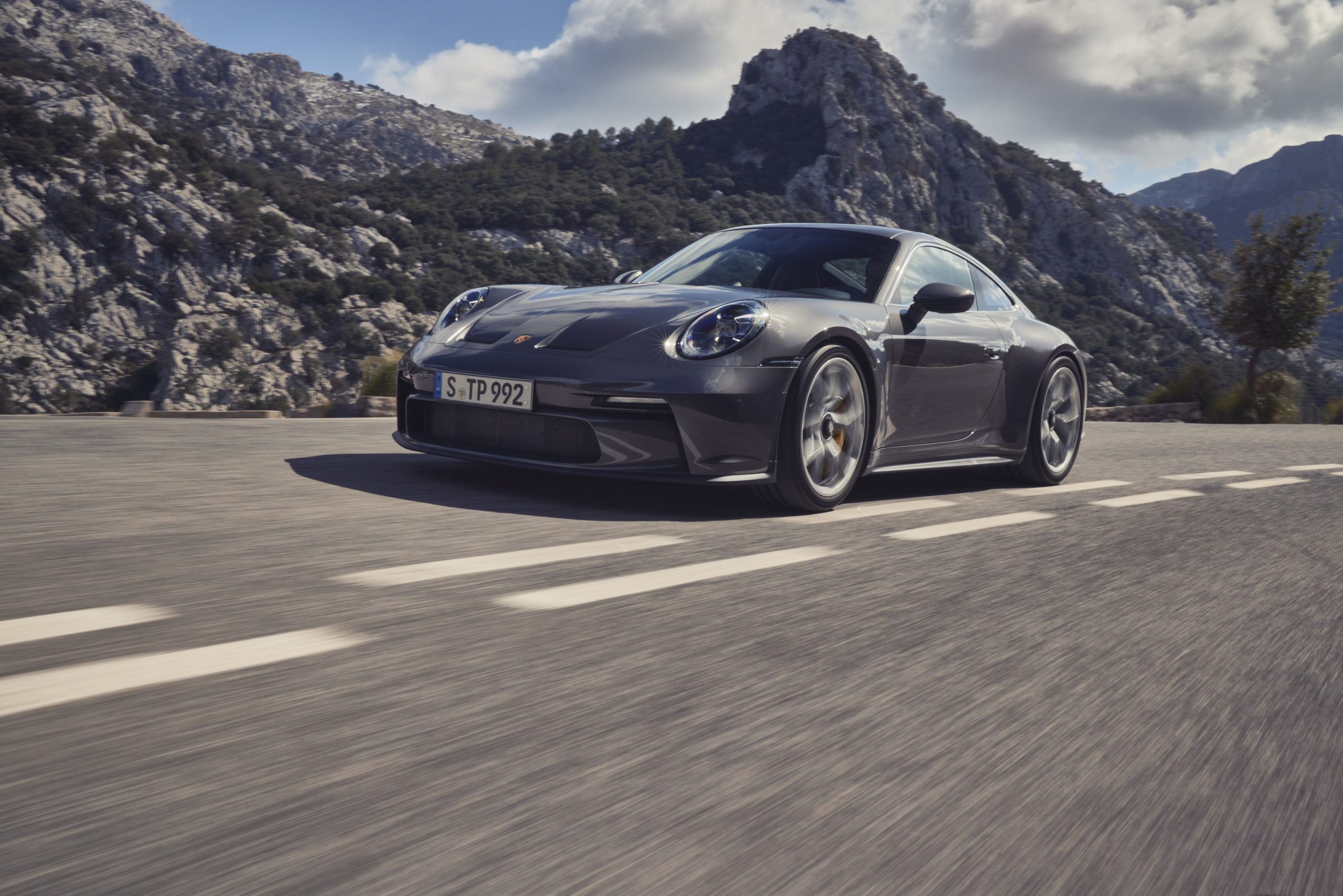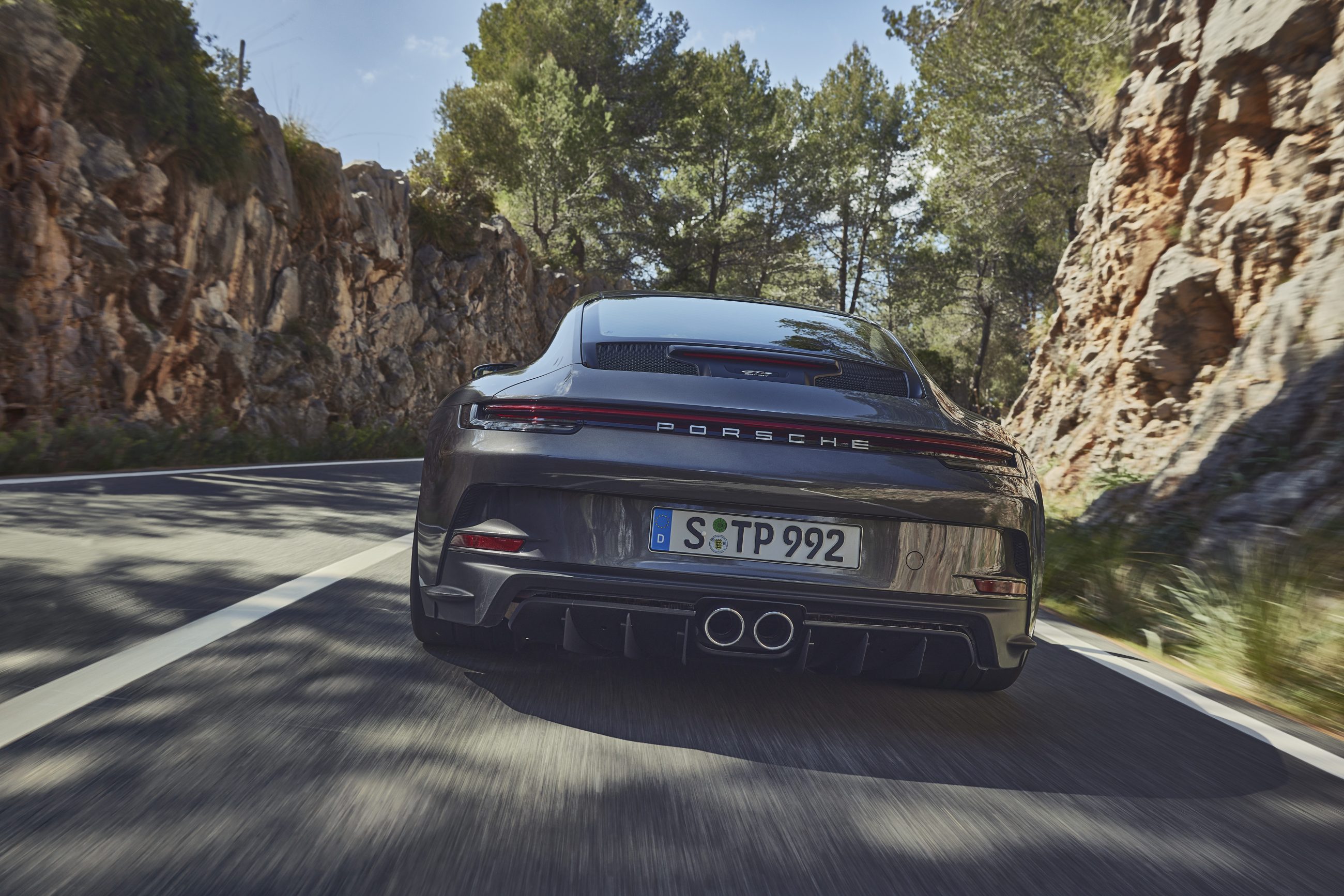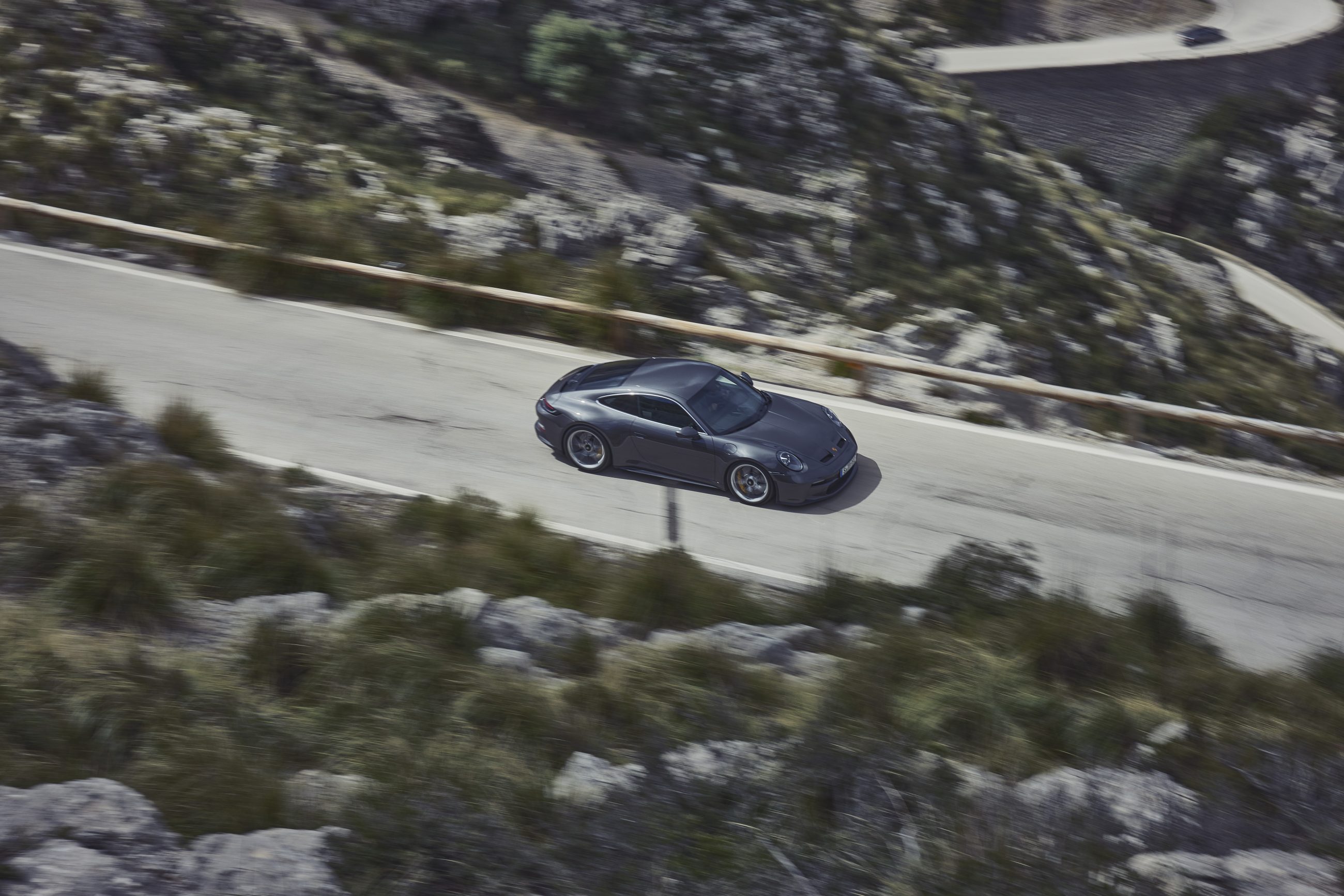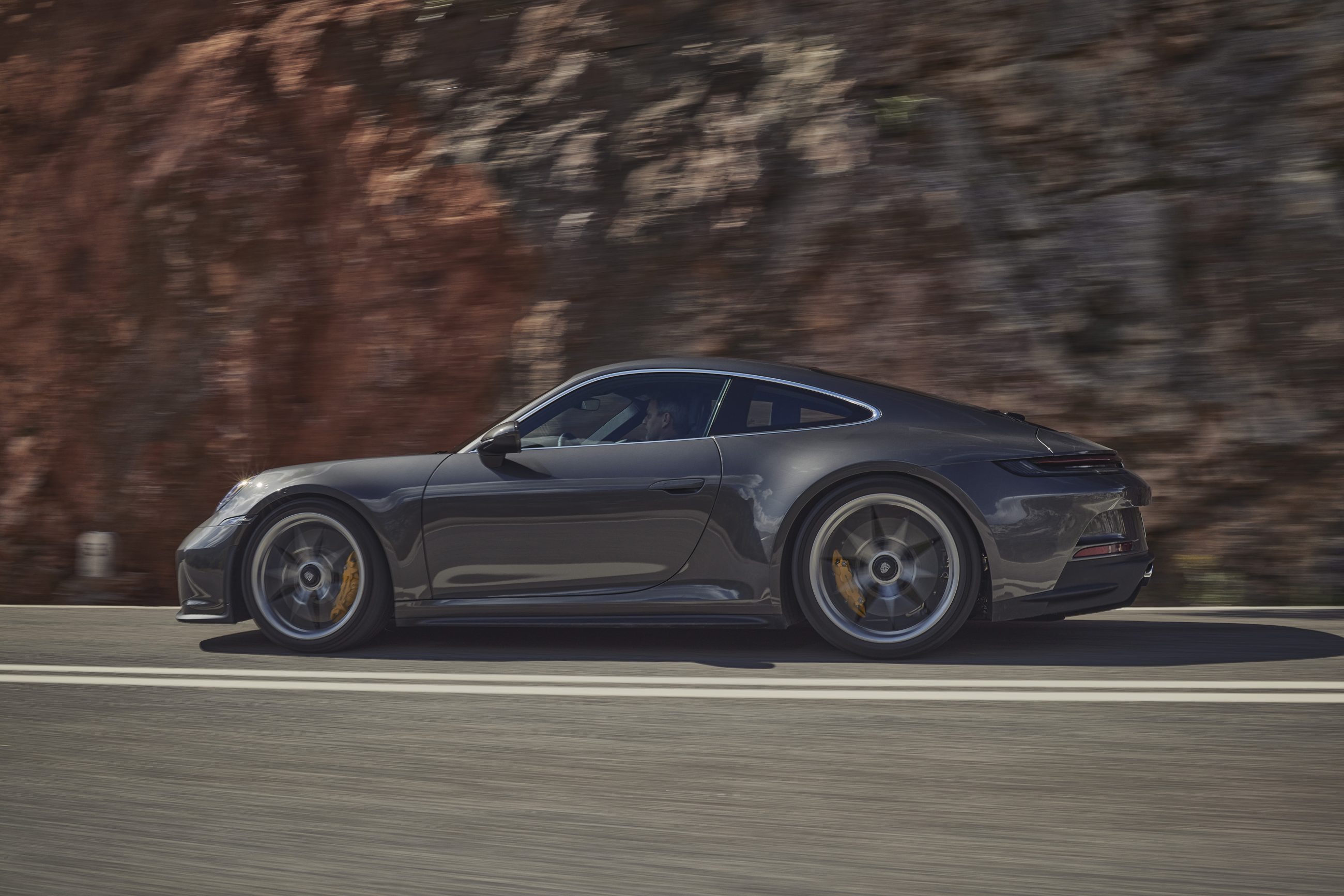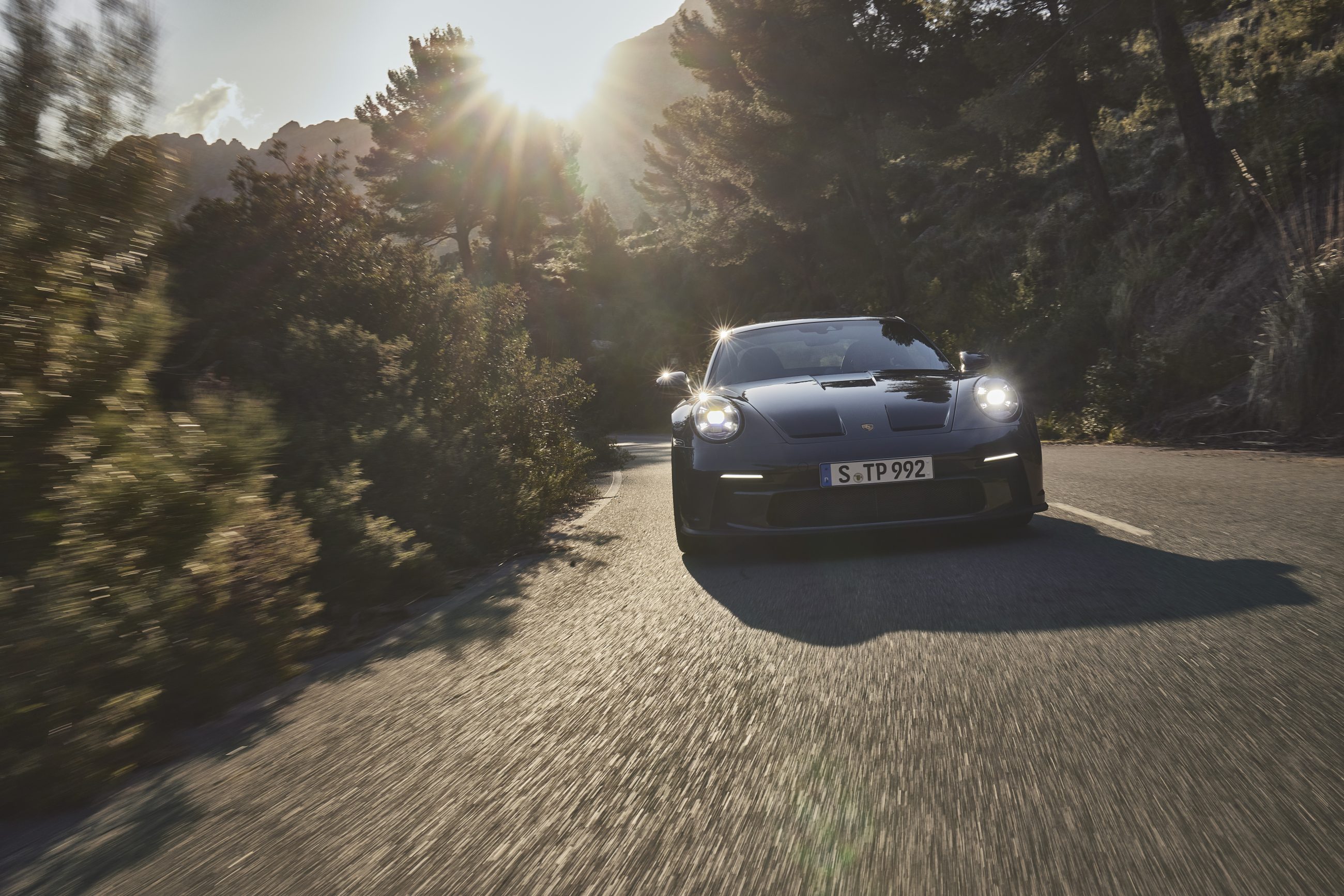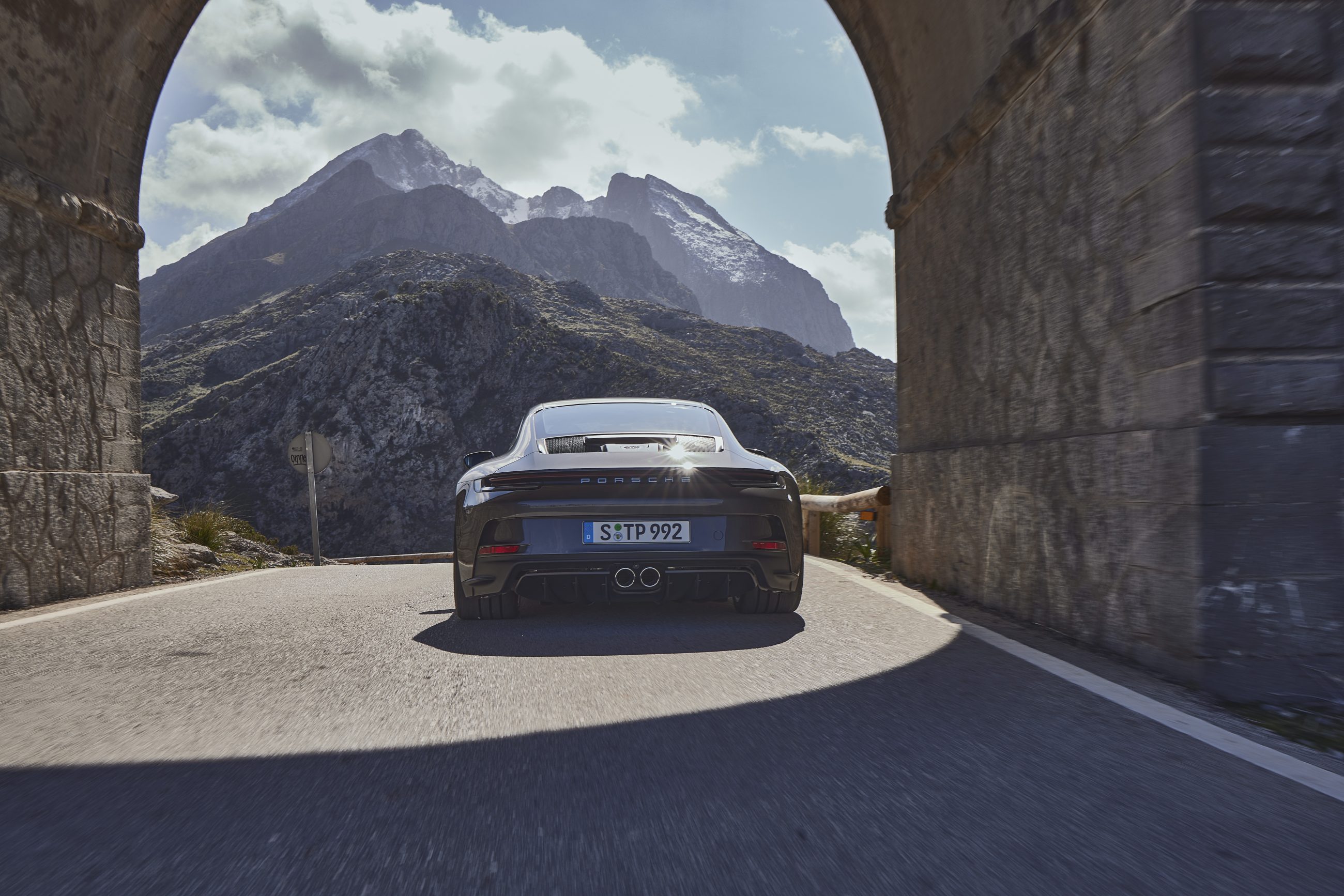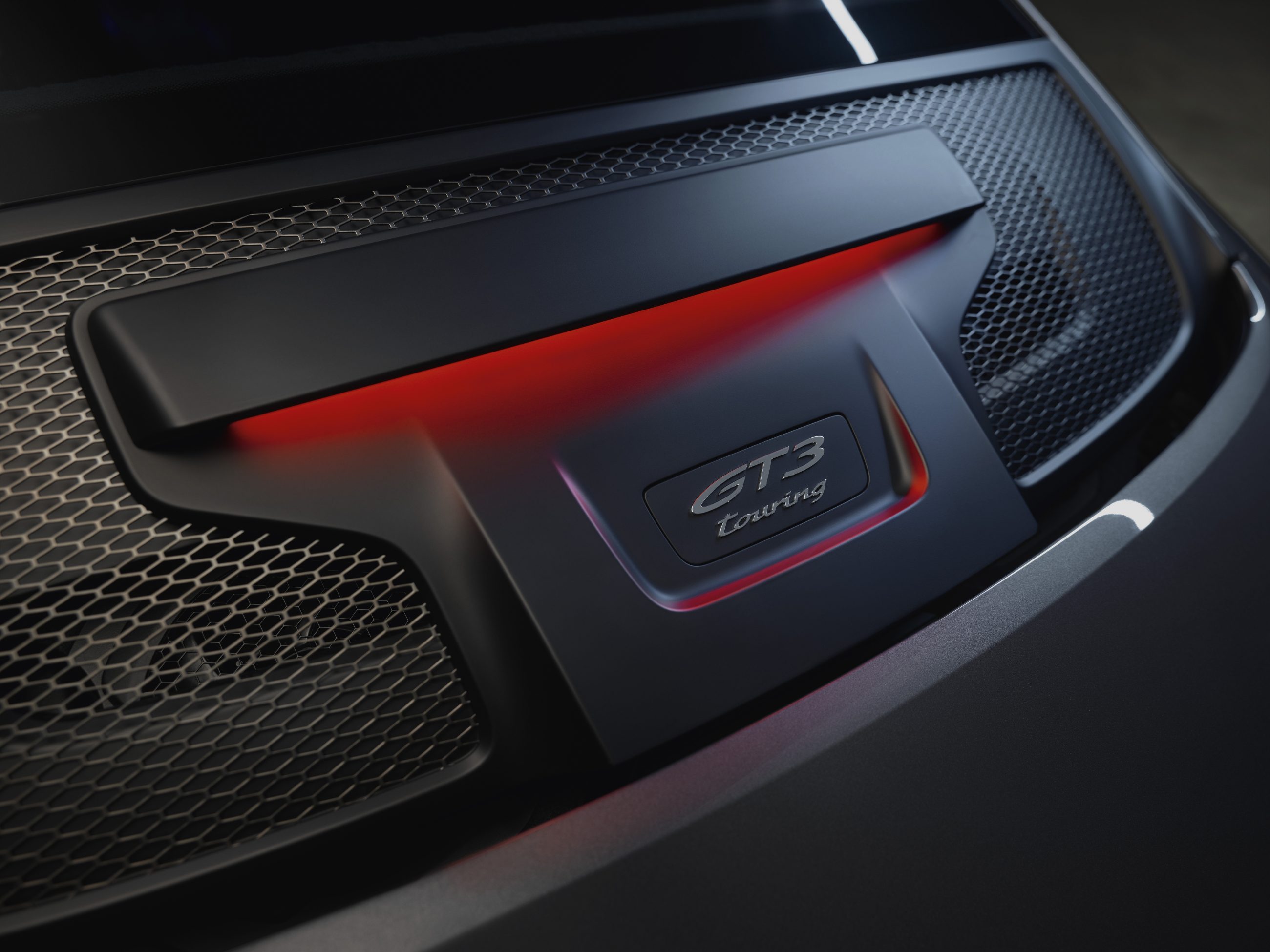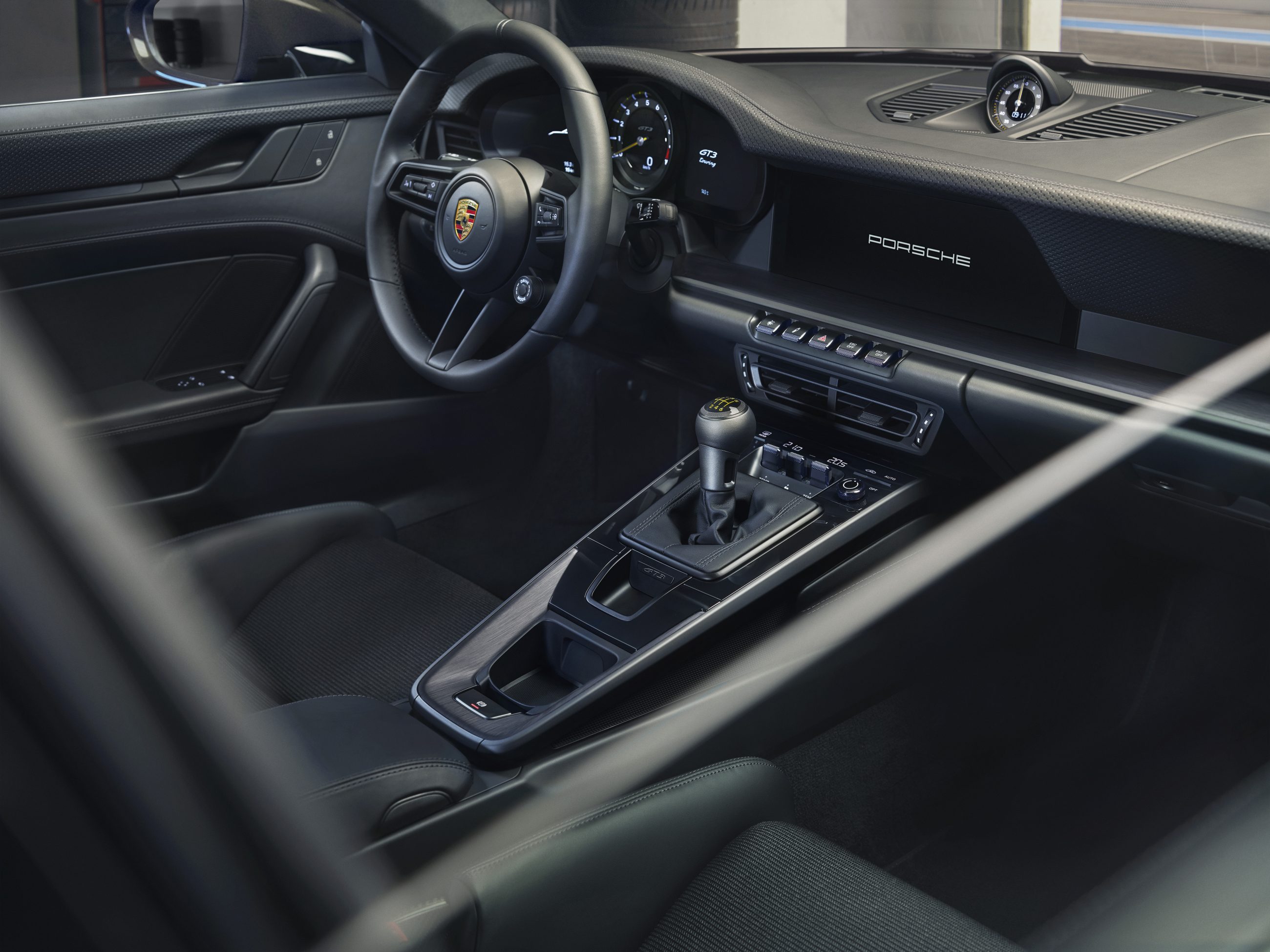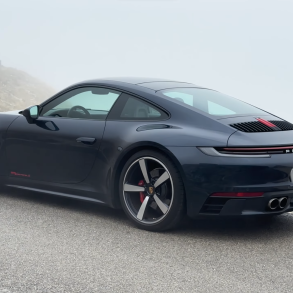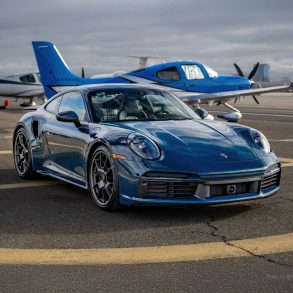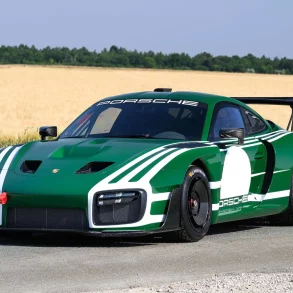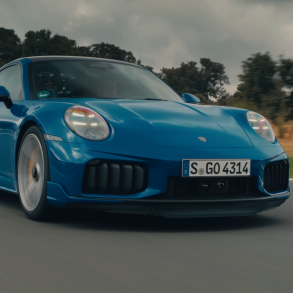2022 – 2024 Porsche 911 GT3 with Touring Package (992.1) – Reviews, Pricing, Specs & Buyers Guide
The Porsche 911 GT3 Touring (992.1) is the stealth fighter of the GT universe: all the motorsport-grade hardware of the winged GT3, minus the swan-neck rear wing and plus a cleaner, classic 911 silhouette. Beneath that subtle decklid lives a 4.0-liter naturally aspirated flat-six that howls to 9,000 rpm and delivers 502 hp and 346 lb-ft, paired to either a 6-speed manual or a 7-speed PDK—both GT-specific gearboxes. The chassis brings the headline engineering leap of the 992 GT3: double-wishbone front suspension adapted from the 911 RSR race car, rear-axle steering, and center-lock wheels. The result is a car that can do Nürburgring-level numbers—but happily vanishes into traffic when you want it to.
Porsche revived the Touring Package for the 991.2 GT3 in 2017 to serve customers who wanted GT3 intensity without the boy-racer aerodynamics. With the 992-generation GT3, the Touring returned in June 2021 as a no-cost configuration that keeps the wingless look, an automatically extending rear spoiler, a model-specific rear grille, and silver window surrounds (satin black optional). Crucially, this time both transmissions were on the menu: in the U.S., PDK was standard with the 6-speed manual a no-cost choice (subject to state availability at launch). Mechanically, the Touring is otherwise identical to the winged GT3; the difference is visual and aero-led.
The Touring brief is “understated performance”—classic 911 cues outside, GT ferocity underneath. That duality made it a darling among enthusiasts and reviewers, many of whom preferred its sleeper aesthetic without giving up a single dynamic advantage in the real world.
Engineering Highlights (Why the 992 GT3/Touring is a Big Deal)
- 4.0-liter NA flat-six, Cup-car lineage: The 9,000-rpm engine (ITBs, dry-sump, rigid valvetrain) is closely related to the GT3 Cup unit, rated at 502 hp and 346 lb-ft. A lighter sport exhaust trims ~22 lb versus the previous generation.
- Race-car front end: First production 911 with a double-wishbone front axle (RSR-derived), bringing better camber control and more faithful steering. At the rear, a refined multi-link with additional ball joints boosts precision; rear-axle steering is standard.
- Serious brakes and tires: 408-mm front rotors (larger than before but lighter), optional PCCB ceramics, and the ability to spec street-legal track tires from the factory.
- Aero without the wing: The Touring trades the GT3’s fixed wing for a powered rear spoiler while retaining the deep, functional diffuser and front aero of the GT3—less downforce than the winged car on track, but the same muscular, natural-aspirated character on the road.
- Weight kept in check: Lightweight glass, center-lock wheels, a LiFePO4 starter battery, and optional carbon roof keep curb weight competitive and responses razor-sharp.
Performance (Claims vs. Reality)
Porsche’s official Touring page lists 502 hp, 331–346 lb-ft depending on market materials, and a top track speed around 193–194 mph (311 km/h). Manufacturer 0–60 claims for the GT3 family are conservative (as usual). Independent numbers tell the real story.
-
Car and Driver instrumented a 2022 GT3 Touring PDK and saw 0–60 mph in 2.8 seconds and a ¼-mile in 11.0 s @ 127 mph, with 1.10 g on their skidpad—essentially dead even with winged GT3 figures when both are on comparable rubber. Their test car weighed 3,334 lb and wore Goodyear Eagle F1 SuperSport R tires (street-friendlier than the Michelin Cup 2 R often fitted to winged cars in tests).
-
MotorTrend’s first test of the 992 GT3 vs. Touring found both cars at 1.19 g average on the skidpad and 22.5 s @ 0.92 g around their figure-eight for the Touring (the winged car: 22.1 s @ 0.95 g), quantifying the lap-time edge that the fixed wing can bring without diminishing the Touring’s brilliance.
-
Porsche’s own GT3 press kit reminds us where these numbers come from: a notarized 6:59.927 at the Nürburgring for the 992 GT3—17.5 seconds quicker than its predecessor—thanks to the new suspension and aero package. (Touring shares the core hardware but gives up wing downforce.)
Takeaway: The Touring is no compromise in the real world. The stopwatch only diverges meaningfully on aero-sensitive tracks; on road tires and your favorite canyon, it’s every bit the same event.
How It Drives
Steering and front-end bite are the 992 GT3/Touring signatures: the RSR-inspired double-wishbone setup gives laser-clean turn-in and mid-corner composure. On imperfect pavement, reviewers repeatedly note that the ride is firm but not punishing, with the springs/dampers keeping body motions tight without clatter. The engine’s razor throttle response (helped by those individual throttle bodies) makes downshifts and corner exits feel telepathic; PDK adds the “always-the-right-gear” magic and devastating launch control, while the 6-speed manual adds an irreplaceable layer of tactility and celebration—Touring DNA at its most romantic. Compared with the winged car, the Touring’s active spoiler quiets some intake roar and takes the race-car look down several notches. For many owners, that’s the whole point: all the GT intensity, none of the visual shouting.
Model-Year Updates
- 2022 (U.S. launch year): Touring returns with PDK standard in the U.S. and manual as a no-cost option (with state-specific availability early on). All the GT3 hardware carries over unchanged: 502 hp NA 4.0, double-wishbone front axle, rear-axle steering, center-locks, track-tire option. Porsche’s PCM 6.0 infotainment received a Jan 24, 2022 software update across the 911 range, improving UI and adding (wireless) Android Auto functionality and native Spotify.
- 2023: Largely carry-over spec with running refinements and additional personalization via Porsche Exclusive Manufaktur—precisely the kind of tailoring Touring buyers seek (two-tone interiors, exterior trims, carbon roof, etc.).
- 2024 (final 992.1 year): Still the same purist NA package before the 2025 992.2 GT3/Touring update. Porsche’s 2024 announcement for the 2025 models maintains the NA engine but details incremental tweaks; that context effectively makes 2022–2024 the clean, first-iteration 992 GT3 Touring years.
Specifications (Highlights)
- Engine: 4.0-liter naturally aspirated flat-six; 502 hp @ 8,400 rpm, 346 lb-ft @ 6,100 rpm; 9,000-rpm redline; individual throttle bodies; dry-sump lubrication.
- Transmissions: 6-speed manual (auto-blip) or 7-speed PDK (GT-specific, 7 ratios).
- Driveline: Rear-engine, RWD, rear-axle steering standard.
- Chassis: Double-wishbone front, refined multi-link rear; adaptive dampers; center-lock 20/21-in wheels; large iron brakes (408-mm front); PCCB optional.
- Aero/Body: Touring deletes fixed wing; active rear spoiler; functional diffuser; lightweight glass; optional carbon roof.
- Performance (typical instrumented): 0–60 mph in 2.8 s (PDK); ¼-mile 11.0 s @ 127 mph; 1.10 g skidpad. Factory top speed ~193–197 mph depending on spec/aero.
Reception & Reviews
- Car and Driver (By the Numbers, 2022 Touring PDK): Celebrated the choice (manual or PDK) and the Touring’s stealth; recorded 2.8 s to 60 and 11.0 @ 127 mph on street-friendlier Goodyears, with 143-ft 70–0 braking and 1.10 g road-holding. Verdict: a “wingless wonder” that’s mechanically identical to the GT3 and scarcely slower in practice. Road & Track (First Drive): “Still hardcore,” praising the chassis accuracy and the way the Touring keeps the GT3’s intensity while looking better to many eyes.
- MotorTrend (First Test): Quantified the tiny performance delta vs. the winged GT3 on their figure-eight and skidpad; both achieved supercar-territory numbers.
Consensus: the GT3 Touring isn’t a detuned GT3; it’s the same weapon under a tuxedo. If you don’t need the fixed-wing lap-time edge, the Touring is the connoisseur’s pick.
Options & Packages That Matter
- Transmission: Manual for involvement; PDK for relentless pace and repeatable launches. With the 992 Touring, both are excellent and widely available—pick with your heart.
- PCCB (ceramic brakes): Lower unsprung mass, stellar fade resistance, and clean wheels; inspect discs carefully on used cars, as stone chips can be costly.
- Seats: The carbon full buckets transform the feel and save weight; 18-way seats are superb for long trips.
- Front-axle lift: Almost mandatory in urban life.
- Tire choice: Michelin Cup 2 / Cup 2 R for maximum bite or Goodyear SuperSport R for a friendlier street-track balance—note that rubber choice can swing test results.
- Exclusive Manufaktur details: Two-tone leather schemes and trim changes unique to Touring can elevate the sleeper vibe significantly.
Buying Guide (Used)
- Aero & body details: Verify the Touring-specific parts (rear grille with “GT3 touring” script, silver window surrounds unless de-chromed, body-color lower front fascia). Plenty of winged GT3s wear low-key colors; it’s the details that prove it’s a Touring.
- Tires & brakes: Check inner shoulders of the 21-inch rears for wear from aggressive alignment; on PCCB, inspect rotor faces for chips. Brake feel should be rock-solid without pulsation.
- Suspension & alignment: The double-wishbone layout is wonderfully precise when aligned correctly. Ask for an alignment sheet; the car should feel straight and settle immediately after quick inputs.
- Software & PCM: Make sure PCM 6.0 is on the Jan 24, 2022 (or newer) software if (wireless) Android Auto or native Spotify matters to you.
- Transmission choice & use-case: If you prioritize track days with traffic lights in between, PDK will be devastatingly effective. If your perfect day is a dawn back-road loop, manual might be the memory-maker. Either way, demand a thorough test drive; the differences are qualitative as much as quantitative.
- Provenance: Stock ECU (no tunes), consistent service records, and PPF on vulnerable panels (front bumper, rocker panels) are all pluses on a car that encourages spirited driving.
Ownership Experience & Verdict
The Touring’s quiet confidence is its trick. It idles unobtrusively in the school pick-up lane, yet the moment you clear traffic it pivots into one of the most energetic, precise driver’s cars on sale. Track-screen displays, shift lights, and the Porsche Track Precision app support lapping days; on the street, the engine’s NA immediacy and that RSR-inspired front end make every modest corner feel special. For many, it’s the sweetest expression of 992: pure combustion, classic looks, and numbers that still leave your jaw on the floor.
If you believe great sports cars should feel effortless and elemental, the 992.1 GT3 Touring is the one. Same Cup-car-tinged hardware as the GT3, a shape that whispers instead of shouts, and performance that—on real roads—matches the winged car stride for stride. Choose your gearbox, spec the seats and brakes that suit your life, confirm the PCM is current, and enjoy the rarest thing in modern performance: drama when you want it, invisibility when you don’t.
What We Said At Launch
When we attended the livestream unveiling of the 992-generation Porsche 911 GT3, it quickly became evident that the folks from Stuttgart had come good on a number of proclaimed and unspoken promises – the new car was far superior to those that came before it, proving that Porsche is not lacking on the level of innovation that’s required to make something so amazing, even better. The event also provided an opportunity for the gaffer to speak about some of the other commitments from the automaker, such as the development of eFuels and the confirmation of an upcoming Touring version for their latest GT car.
For those already in the know, the GT3 Touring model is as exceptional as it has become familiar over the past few years, particularly to the most diehard driving purists and deeply-rooted Porsche enthusiasts. For those wondering, “Hey, what’s the diff?”, the Touring is essentially a gentleman’s version of its otherwise track-focused road car; based on a less extroverted and more purist-centric blueprint, the Touring forgoes some key features from the regular car.
The most notable of these would be the removal of the static rear ‘swan neck’ wing, which has become one of the most defining and differentiating elements of the 992 GT3. It has been replaced by an electronically-controlled retractable wing, which in theory, would serve most of its function under race-track conditions; otherwise, expect the Touring to appear as the wing-less, more unassuming version of itself, in almost all other cases.
In actuality, this helps the car blend in more with the non-GT lineup of 911 cars, rather than simply being a less attention-grabbing version of the GT3. Subtlety is the leading philosophy here – nevertheless, those who know, really know. With that said, this is always one of the best things about owning a Touring model. It’s part of a special ensemble that plays to a small and exclusive audience. These days, being in that kind of company is priceless; in this era where society caters more to bigger egos and louder mouths, the longing to appear as something less, can’t be faked. If anything, it takes some bravery to pull off.
Top Gear: The numbers don’t matter. And that’s an important point to make. Because if they do matter, go and buy electric. You’re looking at the Touring for the wrong reason. This is a car for feels.
Interestingly enough, the 992-generation GT3 Touring model does come with the (no-cost) option to add PDK, though we reckon that manual transmission models will reign supreme as the overwhelming favorite, and for good reason. After all, it makes little sense opting for the former, in the same way that someone would make the argument for having a manual transmission in the GT3 RS because they wanted access to the fastest lap times possible from the car. In any case, Porsche has a proven track record when it comes to satisfying just about every niche via its GT lineup, with the Touring model being one such product of their open dialogue with customers.
For the genesis of the GT3 Touring, we go back to the 991-generation when the series’ first 911 GT3 was released in 2014. It came exclusively with the PDK transmission. This was followed by a bit of an outcry from Porsche customers, who felt that at the very least, the option of a manual transmission GT3 should’ve been on the table from the get-go. Hindsight is always 20/20, and only after-the-fact is it easy to see why a GT3 Touring slots in so perfectly into the 911 hierarchy – it’s the sweet spot for those who desire a 911 grand-tourer and want a bit more than what the GTS offers, but find the Turbo models (for which a manual transmission was not offered) a bit too farfetched.
Car Magazine: Track drivers will want the GT3’s genuine downforce. But for the rest of us the Touring Package is the definitive road-going ‘event’ 911.
Stuttgart heard, and they delivered, though the introduction of the Touring model didn’t happen overnight. The first serving of appeasement came in the form of the manual-transmission-only 911R (which is actually more closely based on the 991.1 GT3 RS model) before a proper commitment was afforded to the 991.2 GT3 in 2017, with the debut of the official Touring designation. It was the first time the 991-generation GT3 could be had with a manual transmission (including the regular model), with the Touring model being exclusively offered with the stick-shift for this iteration.
If you wanted a post-997-generation 911 GT car with a manual transmission, the 2017 GT3 and GT3 Touring were the automaker’s first offering at a relatively reasonable price point; the rarity of the 911R and the fact that it’s basically an RS model, see it demanding inflated prices to this day. With that being said, I don’t think many would have opposed the new 992 GT3 Touring continuing its exclusive relationship with the manual. But it can’t be argued that the PDK opens up more options for a wider range of buyers, which should equate to a larger market share and translate to bigger profits; it makes sense from a business standpoint.
However, we urge buyers of the new GT3 Touring to go all-in on the purity it has on tap, particularly when it comes to being a road car. If lap times are your priority, PDK (on the regular GT3, or the upcoming ‘RS’, if possible) is the way to go. Leave the PDK for what it’s good at. Keep efficiency and essence separate. It’s good for resale value too – maybe you’ll thank me later. Speaking of the 911R, perhaps a 992 iteration is in the pipeline? Though this time, we reckon it will be more in parallel with the RS program from the get-go (as it ended up being the first time), rather than a knee-jerk reaction to the lukewarm reception of a manual-transmission-less GT3. One can only hope!
Porsche has continued the use of the naturally-aspirated 4.0L 9A1 flat-6 power plant in the 2022 Porsche 911 GT3, with that engine carrying over untouched in the GT3 Touring. The only key differences between the 9A1 and the engine used in the Cup race car, are the exhaust system and ECU. Otherwise, those two engines share virtually all the same components, such as individual throttle bodies. As such, the new GT3 needed no “sound engineering” and inherently sounds amazing.
With its astronomical 9,000 rpm redline, the GT3 Touring produces 502 hp @ 8,400 rpm and 346 lb-ft of torque @ 6,250 rpm and should likewise achieve hugely similar, if not identical figures as it pertains to 0-60 mph times and top speed. Like the regular model, the Porsche 911 GT3 Touring comes with two transmission options, though as mentioned before, the 6-speed manual is expected to be the much more popular choice for buyers of this model. The GT3 and GT3 Touring continue to use the 7-speed PDK transmission, instead of a version of the 8-speed used in the rest of the 992 line-up.
Purists, rejoice! Dr. Frank Walliser – Vice President of 911 and 718 Product Lines – said that we shouldn’t count on the GT3 going electric or even hybrid, anytime too soon. It is much more likely that Porsche will transition to using synthetic fuels for motorsport and its GT line of production cars, before even considering going full-on EV. This aligns with Porsche’s intention to keep the naturally-aspirated engine alive for as long as possible – regulations and emissions standards will serve as the eventual ultimatum.
The new 992 GT3 spent more than 160 hours across 700 simulation sessions in the wind tunnel. It generates 50% more downforce than its predecessor and up to 150% more downforce in its “high downforce” setting. Porsche has claimed that the retractable spoiler on the GT3 Touring model – while fully extended – is able to generate the same amount of downforce as the regular model’s affixed version, though it is unclear if they are including the “high downforce” setting in this comparison.
Otherwise, the GT3 Touring uses all of the same aero components including an adjustable front diffuser and a fully closed rear diffuser, which on its own generates 60 kg of downforce at top speed. Its low weight of just 1,413 kg is achieved with a myriad of lightweight components, and next to an equally-optioned GT3, it should weigh in about the same. This includes a carbon-fiber hood, roof, and rear wing, along with other items such as a super lightweight battery, lighter wheels, ultra-thin glass, carbon-fiber cross members, and lightweight interior appointments. Essentially, the 992 GT3 and GT3 Touring have achieved the same weight as their predecessors, but are loaded with a lot more technology.
In this department, the GT3 Touring is also identical to the GT3. Expect the same 911-RSR-inspired handling characteristics that are spearheaded by the introduction of a new front suspension setup consisting of unequal-length control arms instead of conventional struts, making it the first time a double-wishbone suspension configuration is used in the front of a GT3. This will provide better tire contact through turns and during moments of compression and rebounding. Porsche’s new adaptive dampers are capable of adjusting every 10 milliseconds, which means the spring rates have doubled without affecting the ride quality of the GT3.
There are three available driving modes: Normal, Sport, and Track, which all provide varying degrees of driver-aid involvement and chassis settings. Aside from providing the most firm, performance-biased setup with the least amount of computer control, initiating Track mode also changes the instrumentation and displays to “Track View”. This compiles all pertinent information to the immediate field of view of the driver. Important details such as oil temperature, oil pressure, tire pressures, and shift indicators, are all in plain sight and easily visible.
Both the GT3 and GT3 Touring draw their standard features and optional equipment from the same parts bin, with the latter car also coming standard with cast-iron rotors and Michelin Pilot Sport Cup 2 tires. Likewise, upgrading to carbon-ceramic brakes and Michelin Pilot Sport Cup 2R tires, remain as options.
This, of course, is where the GT3 Touring truly begins its quest to make a name for itself, with both of the current GT3 variants being virtually identical otherwise. It really comes down to what kind of visual signals you’re intending to give off while driving the GT3 (and the resulting levels of attention you want to grab or avoid). It’s not even a question of aerodynamic performance either – as many would understandably expect – with the downforce generated remaining unchanged regardless of whether you go fixed-wing or adaptive. Porsche was adamant on lending to its mantra that subtlety doesn’t need to come with any penalty, and made sure the GT3 Touring was engineered and designed in such a mold.
EVO: There are few, if any, more rewarding, engaging, or intense experiences for those in pursuit of the thrill of driving.
There are a number of other aesthetic details that are unique to the Touring model as well, though they’re not as individually pronounced as the rear spoiler changes. In keeping with the now deep-rooted philosophy of Touring models, standard features such as painted front bumper inserts, aluminum window trimming, and an interior wrapped in leather and brushed aluminum (in place of Alcantara and carbon fiber), give the latest GT3 variant a more reserved persona.
That’s not to say that the Touring has been in any way, emasculated as a GT car; if nothing, it’s simply a more mature version of itself. After all, the remaining presence of distinguishable cues such as carbon fiber bonnet vents, a front bumper with large air intakes, and a signature GT-department engine cover, provide enough hints that this isn’t just a fancy looking Carrera S. While you can spec a Touring model to be as hardcore as its more track-purposed stablemate, do so with some introspection.
For example, as cool as those lightweight carbon fiber bucket seats are, they make getting into and out of the car more difficult. This would make the case for the Touring model being a more dedicated daily driver, a bit harder to argue. Before checking all the boxes on the options list, just know what you’re getting (and why), and you won’t be disappointed. Overall, the silhouette of the new 911 GT3 Touring remains a largely familiar one – and that’s not a bad thing. In fact, this is probably great news for Porsche and GT3 enthusiasts, who would contend that there was never anything wrong with the previous GT3 in the first place.
No confirmation yet on whether the Club Sport Package (roll cage, 4-pt harnesses) will continue to be a no-cost option, as it is in the regular GT3. If it is, it would probably only be for the European markets anyway – this package was not available on past iterations in North America due to safety regulations. Again, like PDK, the Club Sport Package kind of clashes with the whole purpose of the Touring model, in our opinion. Paint to Sample (aka, custom paint colors) will also be available for GT3 Touring examples.


